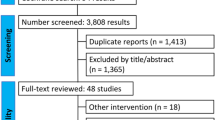Abstract
Introduction
Negative pressure wound therapy (NPWT) is widely used in the treatment of open abdomen (OA). The use of dynamic fascial sutures (DFS) increases the rate of successful delayed closure by reducing fascial lateralization. We recently published a prospective controlled trial including 87 patients undergoing abdominal surgery for secondary peritonitis between 2007 and 2012. Patients were treated with NPWT and DFS for approximation of fascial edges. The present study represents a follow-up assessment of these patients 5–9 years after OA treatment with NPWT and DFS.
Methods
The 39 patients still alive were included in the recent study according to the protocol of our last study in 2013. All patients received a questionnaire regarding long-term complications after OA treatment between 2007 and 2012. Mean follow-up was 5–9 years. Analyzed parameters included pain, the presence of incisional hernia, and subsequent surgical interventions. Results were analyzed quantitatively.
Results
One patient had deceased since the last publication in 2013, and hence 38 patients were included in the current study. The median age was 60.9 (25.2–86.1) years, and 17 (44.7%) were females. Overall 56.3% of the original 87 patients had died during the long-term follow-up period. 21 patients (55.3%) answered the questionnaire. Six (28.6%) declared that they suffered from pain in the previous operating field, five (23.8%) at rest, and three (14.3%) during exercise. In five patients (23.8%), pain lasted for more than 3 months. One patient (4.8%) still requires analgesic treatment. Among the 21 patients, seven (33.3%) were found to have incisional hernias. Three hernias (42.9%) were treated by surgery.
Conclusion
Incisional hernia rates after OA treatment remain high, but are accompanied by little pain. The ideal technique of fascial closure after NPWT should be investigated in further research.




Similar content being viewed by others
References
Dietz UA, Wichelmann C, Wunder C et al (2012) Early repair of open abdomen with a tailored two-component mesh and conditioning vacuum packing: a safe alternative to the planned giant ventral hernia. Hernia 16:451–460. doi:10.1007/s10029-012-0919-0
Keramati M, Srivastava A, Sakabu S et al (2008) The Wittmann Patch s a temporary abdominal closure device after decompressive celiotomy for abdominal compartment syndrome following burn. Burns 34:493–497. doi:10.1016/j.burns.2007.06.024
Koniaris LG, Hendrickson RJ, Drugas G et al (2001) Dynamic retention: a technique for closure of the complex abdomen in critically ill patients. Arch Surg 136:1359–1362 (discussion 1363)
Kafka-Ritsch R, Zitt M, Schorn N et al (2012) Open abdomen treatment with dynamic sutures and topical negative pressure resulting in a high primary fascia closure rate. World J Surg 36:1765–1771. doi:10.1007/s00268-012-1586-0
Petersson U, Acosta S, Björck M (2007) Vacuum-assisted wound closure and mesh-mediated fascial traction—a novel technique for late closure of the open abdomen. World J Surg 31:2133–2137. doi:10.1007/s00268-007-9222-0
Björck M, Bruhin A, Cheatham M et al (2009) Classification—important step to improve management of patients with an open abdomen. World J Surg 33:1154–1157. doi:10.1007/s00268-009-9996-3
Boele van Hensbroek P, Wind J, Dijkgraaf MGW et al (2009) Temporary closure of the open abdomen: a systematic review on delayed primary fascial closure in patients with an open abdomen. World J Surg 33:199–207. doi:10.1007/s00268-008-9867-3
Miller PR, Meredith JW, Johnson JC, Chang MC (2004) Prospective evaluation of vacuum-assisted fascial closure after open abdomen. Ann Surg 239:608–616. doi:10.1097/01.sla.0000124291.09032.bf
Latifi R, Joseph B, Kulvatunyou N et al (2012) Enterocutaneous fistulas and a hostile abdomen: reoperative surgical approaches. World J Surg 36:516–523. doi:10.1007/s00268-011-1306-1
Bjarnason T, Montgomery A, Ekberg O et al (2013) One-year follow-up after open abdomen therapy with vacuum-assisted wound closure and mesh-mediated fascial traction. World J Surg 37:2031–2038. doi:10.1007/s00268-013-2082-x
Kreis BE, de Mol van Otterloo AJ, Kreis RW (2013) Open abdomen management: a review of its history and a proposed management algorithm. Med Sci Monit 19:524–533. doi:10.12659/MSM.883966
Fortelny RH, Hofmann A, Gruber-Blum S et al (2014) Delayed closure of open abdomen in septic patients is facilitated by combined negative pressure wound therapy and dynamic fascial suture. Surg Endosc 28:735–740. doi:10.1007/s00464-013-3251-6
Petersson U, Bjarnason T, Björck M et al (2016) Quality of life and hernia development 5 years after open abdomen treatment with vacuum-assisted wound closure and mesh-mediated fascial traction. Hernia. doi:10.1007/s10029-016-1516-4
Brandl A, Laimer E, Perathoner A et al (2014) Incisional hernia rate after open abdomen treatment with negative pressure and delayed primary fascia closure. Hernia 18:105–111. doi:10.1007/s10029-013-1064-0
Diener MK, Voss S, Jensen K et al (2010) Elective midline laparotomy closure: the INLINE systematic review and meta-analysis. Ann Surg 251:843–856. doi:10.1097/SLA.0b013e3181d973e4
Israelsson LA, Millbourn D (2012) Closing midline abdominal incisions. Langenbeck’s Arch Surg/Dtsch Gesellschaft für Chir 397:1201–1207. doi:10.1007/s00423-012-1019-4
Bosanquet DC, Ansell J, Abdelrahman T et al (2015) Systematic review and meta-regression of factors affecting midline incisional hernia rates: analysis of 14,618 patients. PLoS ONE 10:e0138745. doi:10.1371/journal.pone.0138745
Millbourn D, Cengiz Y, Israelsson LA (2011) Risk factors for wound complications in midline abdominal incisions related to the size of stitches. Hernia 15:261–266. doi:10.1007/s10029-010-0775-8
Millbourn D, Cengiz Y, Israelsson LA (2009) Effect of stitch length on wound complications after closure of midline incisions: a randomized controlled trial. Arch Surg 144:1056–1059. doi:10.1001/archsurg.2009.189
Acknowledgements
The authors thank Ilse Jung for statistical analysis.
Author information
Authors and Affiliations
Corresponding author
Ethics declarations
Disclosures
Drs. Anna Theresa Hofmann, Simone Gruber-Blum, Michael Lechner, Alexander Petter-Puchner, Karl Glaser, and René Fortelny have no conflicts of interest or financial ties to disclose.
Rights and permissions
About this article
Cite this article
Hofmann, A.T., Gruber-Blum, S., Lechner, M. et al. Delayed closure of open abdomen in septic patients treated with negative pressure wound therapy and dynamic fascial suture: the long-term follow-up study. Surg Endosc 31, 4717–4724 (2017). https://doi.org/10.1007/s00464-017-5547-4
Received:
Accepted:
Published:
Issue Date:
DOI: https://doi.org/10.1007/s00464-017-5547-4




